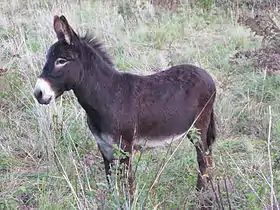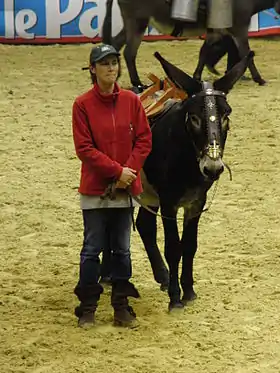Pyrenean donkey
The Pyrenean donkey, French: Âne des Pyrénées, is a breed of domestic donkey from a large area of south-western of France, covering the whole of the regions of Aquitaine, Midi Pyrénées and Languedoc Roussillon. The largest concentration is in Aquitaine, which is a large part of the historic region of Gascony. The Pyrenean donkey breed unites two quite different types: the short and powerful Gascon type, and the taller and more elegant Catalan type, which is the French population of the Catalan donkey breed, approximately 20% of the total number of which is in the Roussillon.[4]
 | |
| Conservation status | FAO (2007): no data[1] SAVE (2008): critical[2]:25–26 |
|---|---|
| Other names | Âne des Pyrénées |
| Country of origin | France |
| Distribution | south-western France |
| Standard | Ministère de l'Agriculture |
| Traits | |
| Height | |
| Coat | glossy black, near-black, pangaré black, or chestnut bay[3] |
| |
History
The Pyrenean donkey was flourishing at the start of the twentieth century; the First World War reduced rural populations, and the donkey population also fell. The effects of the mechanisation of agriculture and transport led to a greater decline. The lowest point was reached in the 1990s,[5] when no more than 20 animals remained.[6] The breed was reconstituted with stock imported from Spain.[6] A breeders' association, the Association des Eleveurs d'Anes des Pyrénées, was formed in 1994, and in 1997 the breed was officially recognised by the ministry of agriculture and the Haras Nationaux. The association maintains the stud book for the breed.[7]
Characteristics


Jacks of the Gascon type stand 1.25–1.35 metres (49–53 in) at the withers, and jennies 1.20–1.30 metres (47–51 in). Catalan jacks measure a minimum of 1.35 metres (53 in), and jennies a minimum of 1.30 metres (51 in); there is no maximum height for the Catalan type.[3]
The coat may be glossy black, near-black, pangaré black, or chestnut bay.[3] The lower part of the muzzle and the surround of the eyes are pale, as is the belly; there is no dorsal stripe, shoulder-stripe or zebra-striping of the legs.[3] Most physical characteristics differ between the two types.
Use
The Gascon type was used for agricultural work, both in harness and as a pack animal, carrying wood, hay, ice and the like.[8] As in the past, Catalan jacks are used to sire mules; they may be bred with Castillonnais, Mérens or Navarrin mares of the region.[6]
Pyrenean jennies may also be used to produce asses' milk for cosmetic use.[9]
References
- Barbara Rischkowsky, D. Pilling (eds.) (2007). List of breeds documented in the Global Databank for Animal Genetic Resources, annex to The State of the World's Animal Genetic Resources for Food and Agriculture. Rome: Food and Agriculture Organization of the United Nations. ISBN 9789251057629. Accessed July 2014.
- Waltraud Kugler, Hans-Peter Grunenfelder, Elli Broxham (2008). Donkey Breeds in Europe: Inventory, Description, Need for Action, Conservation; Report 2007/2008. St. Gallen, Switzerland: Monitoring Institute for Rare Breeds and Seeds in Europe. Archived 2 September 2009.
- Patrick Falcone (16 January 2012). Annexe I: Standard de l'âne des Pyrénées (in French). Annex to: Arrêté du 16 janvier 2012 modifiant l'arrêté du 14 novembre 2002 modifié portant approbation du règlement du stud-book de l'âne des Pyrénées et du mulet des Pyrénées, Ministère de l'agriculture, de l'alimentation, de la pêche, de la ruralité et de l'aménagement du territoire. In: Journal officiel "Lois et Décrets" 0020, 24 January 2012: 1341. Accessed July 2014.
- Raza equino asnal CATALANA: Datos censales (in Spanish). Ministerio de Agricultura, Alimentación y Medio Ambiente. Accessed July 2014.
- L'âne des pyrénées, riche héritier de traditions séculaires (in French). Association des Eleveurs d'Anes des Pyrénées. Accessed July 2014.
- Lætitia Bataille (2008). Âne des Pyrénées (in French). In: Races équines de France. France Agricole Éditions. ISBN 9782855571546. 265–268.
- L'association: Son histoire (in French). Association des Eleveurs d'Anes des Pyrénées. Accessed July 2014.
- Serge Farissier (2007). L'âne des Pyrénées (in French). In: L'âne. Editions Artemis. ISBN 9782844166425. p. 76–77.
- L'âne des Pyrénées (in French). Haras nationaux Accessed July 2014.